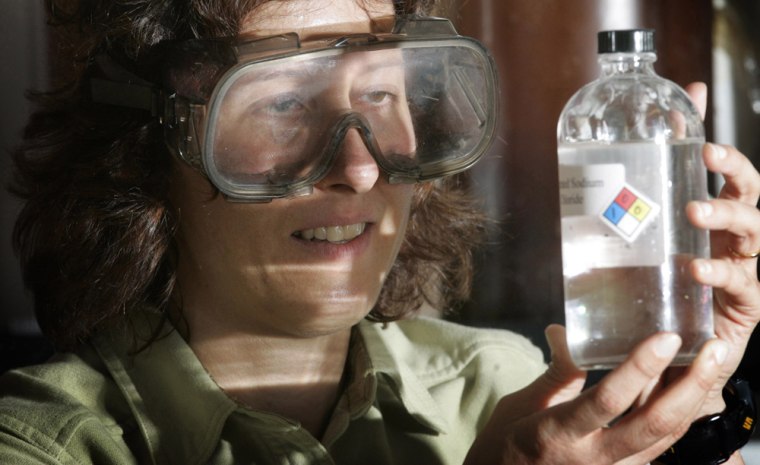Remember the famous line from the classic movie, "The Graduate," when a helpful family friend whispers to a young Dustin Hoffman that there is one magic word of advice for the future — "plastics"?
The leaders of a growing scientific revolution called "green chemistry" might rephrase the line to something more modern like, "biodegradable, renewable, nontoxic and environmentally friendly plastics."
They say the world can no longer afford the pollution and health risks associated with toxic industrial chemicals to make plastics, drugs, paper and most of the things taken for granted in everyday life.
"For many people, chemistry is dangerous, scary stuff — I think they have a hard time seeing the future where we can do chemistry safely," said Ken Doxsee, a University of Oregon chemist who is one of the leaders of the movement to educate the next generation of scientists and industrial researchers about green chemistry.
The concept has been embraced by the American Chemical Society as one of the best ways to reduce pollution while cutting the huge cost of toxic waste disposal and cleanup, making it more profitable for industries to switch to safer chemicals.
"Chemists are getting very good at designing molecules," said Paul Anastas, director of the society's Green Chemical Institute.
Designing profits
"You can design them to be toxic or nontoxic, hazardous or nonhazardous. What people didn't expect is that it was going to be more profitable," Anastas said.
Last year, for example, DuPont Co. agreed to pay about $340 million to settle a class-action lawsuit claiming it "contaminated" water supplies in Ohio and West Virginia with a chemical used to make the popular non-stick coating Teflon.
But DuPont also has been one of the companies pushing hard toward alternatives, recently developing a way to spin fiber for fabric and clothing with a biochemical substance called a polymer that is derived from corn.
The fiber, called Sorona, requires 40 percent less energy to manufacture than other synthetic fibers and helped DuPont win the presidential green chemistry award from the U.S. Environmental Protection Agency in 2003.
"It's just one of many projects we're developing," said Michelle Reardon, a DuPont spokeswoman.
Nobel kudos, Greenpeace skepticism
The green chemistry movement got a big boost this past Wednesday when two Americans and a French scientist won the Nobel Prize for developing a chemical process called metathesis that can be used to make plastics, drugs and other products more efficiently with fewer environmental hazards.
One of the trio, Richard Schrock of the Massachusetts Institute of Technology, first worked on the process when he was at DuPont in the 1970s, Reardon noted.
Despite the increasing enthusiasm for green chemistry, it may take years before it becomes the standard for research and industry. And critics say it may take even longer.
"It's virtually all just potential at this point," said Rick Hind, legislative director of the Greenpeace Toxics Campaign.
"We don't know of any truly enlightened chemical companies. What they call green chemistry we call 'greenwash' because it's all public relations."
Corporations have little incentive to modernize aging chemical plants that remain profitable and plenty of motivation to delay lawsuits and force settlements that are cheaper than making changes or building new plants, Hind said.
"I think the industry's trap is they're in a quarter-to-quarter profit cycle," Hind said.
"They'll be in these plants until they fall over, and then they'll move to Mexico," he said. "Meanwhile, the plants don't cost them much and they get tax writeoffs and don't innovate."
Hind said Congress also deserves blame for the lack of incentive to make changes. He said lawmakers could be doing much more to encourage green chemistry alternatives.
"Usually the laws are relatively weak and have been written by lobbyists for the industry," Hind said.
Petroleum and plastics
George Whitesides of Harvard University, considered one of the pioneers in biochemistry, said the declining supply of crude oil will push the industry to adopt alternatives because much of the feedstock for chemicals such as plastics and drugs comes from petroleum.
"The highest value for oil is going to be feedstocks for chemicals," Whitesides said. "It's pretty much indefensible to just burn it in SUVs."
Engineering alternative chemicals will become vital to weaning the nation off gasoline, minimizing pollution and boosting profits that companies need to invest in modernization and create more jobs, he said.
Meanwhile, disasters like the recent hurricanes that struck the Gulf Coast are a reminder to everyone involved in chemical research that it is much cheaper to develop safer chemicals than it is to clean up tons of toxic sludge.
"I like to think about what politicians would do if they had more courage," Hind said. "This is America. We're supposed to be 'can do,' not 'can't do.'"
